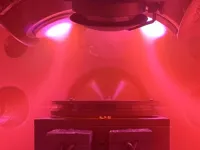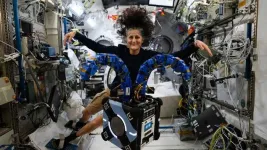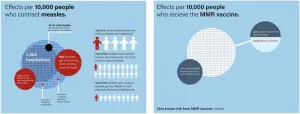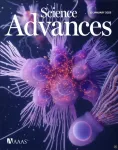(Press-News.org) UNIVERSITY PARK, Pa. — Ferroelectrics are special materials with polarized positive and negative charges — like a magnet has north and south poles — that can be reversed when external electricity is applied. The materials will remain in these reversed states until more power is applied, making them useful for data storage and wireless communication applications.
Now, turning a non-ferroelectric material into one may be possible simply by stacking it with another ferroelectric material, according to a team led by scientists from Penn State who demonstrated the phenomenon, called proximity ferroelectricity.
The discovery offers a new way to make ferroelectric materials without modifying their chemical formulation, which commonly degrades several useful properties. This has implications for next-generation processors, optoelectronics and quantum computing, the scientists said. The researchers published their findings today (Jan 8) in the journal Nature.
“This work shows we can generate ferroelectricity in a material that does not have those properties just by stacking it with a material that is ferroelectric,” said Jon-Paul Maria, professor of materials science and engineering at Penn State and lead author of the study. “And, so, it has to be that the two materials are talking to each other. We call it proximity ferroelectricity because it is an effect of being in contact.”
In recent years, scientists at the University of Kiel in Germany and at Penn State have developed new families of nitride and oxide ferroelectric materials — respectively — with comparable properties but with much simpler structures and preparation methods that can be integrated directly into mainstream semiconductors, like silicon, thus maximizing the technology impact, the scientists said.
The new work builds on those discoveries, demonstrating a method to create similar materials but without needing the chemical modifications previously required for fabrication, the scientists said.
“The community got very excited in the last few years about two new emergent families of ferroelectrics that show very promising future impacts on electronic devices,” Maria said. “This is now another step in that process. It’s a second time that we’ve been stunned about what we did not know about ferroelectricity after 100 years of research.”
Maria and his team previously developed one such ferroelectric material that offers enticing performance but requires trade-offs: magnesium-substituted zinc oxide thin films. The zinc oxide has desirable properties, but it is not ferroelectric by itself. Adding magnesium allows scientists to make the material ferroelectric but degrades important properties such as heat dissipation during device operation and the ability to transmit light over very long distances.
Using proximity ferroelectricity, the researchers found they could now turn pure zinc oxide ferroelectric by stacking it with a ferroelectric material like the magnesium-substituted zinc oxide thin films.
“Imagine that I have the ability to stack these layers on top of each other, where one is ferroelectric and the other is normally not, but through proximity ferroelectricity,” Maria said. “It can exhibit the polarization reversal in its pure state. That’s the real appeal.”
In addition, the ferroelectric layer can represent as little as 3% of the total volume of the stack, meaning the vast majority is material with the most-desired properties. The ferroelectric, or switching layer, can be placed on the top or bottom or as an isolated internal layer, the scientists said.
The researchers observed proximity ferroelectricity in oxide, nitride and combined nitride-oxide systems, suggesting that there is a generic mechanism and that the technique could provide new avenues for ferroelectric property engineering and material discovery.
Maria said the work only scratches the surface of what’s possible with the technique and that future research should explore other possible compositions.
The technology could be especially useful for developing next-generation optics applications for electronics. A major challenge in computing involves finding ways to use less energy — and one option is changing the way processors talk to each other using light instead of electronics, Maria said.
“And a big part of that may be this next generation of opto-electronic materials,” Maria said. “Our findings could be one candidate. Alternatively, this could mean that other enabling materials are already known, and exciting functional properties like ferroelectric switching just need unlocking using this proximity effect.”
Also contributing from Penn State were: Chloe Skidmore, a graduate student and lead author; Devin Goodling, John Hayden, R. Jackson Spurling, Steven Baksa, Albert Suceava, and Joshua Nordlander, who contributed as graduate students; and Joseph Casamento, a post-doctoral scholar. Contributing faculty members include Susan Trolier-McKinstry, Evan Pugh University Professor and Steward S. Flaschen Professor of Ceramic Science and Engineering; Venkatraman Gopalan, professor of materials science and engineering and physics; and Betul Akkopru-Akgun, assistant research professor in the Materials Research Institute;
Also contributing were: Elizabeth Dickey, distinguished professor, Ismaila Dabo, professor, and Sebastian Calderson, special faculty, at Carnegie Mellon University; Andrew Rappe, professor, and Drew Behrendt, doctoral student, at the University of Pennsylvania; and Kyle Kelley, research and development associate at Oak Ridge National Laboratory.
The U.S. Department of Energy, the U.S. National Science Foundation and the Department of Defense provided support to researchers on this project.
END
Proximity effect: Method allows advanced materials to gain new property
2025-01-08
ELSE PRESS RELEASES FROM THIS DATE:
LJI researchers shed light on devastating blood diseases
2025-01-08
LA JOLLA, CA—Scientists at La Jolla Institute for Immunology (LJI) have discovered how a mutated gene kicks off a dangerous chain of events during blood cell production.
The study, published recently in the Proceedings of the National Academy of Sciences, reveals how a mutated gene called ASXL1 is involved in a disease called clonal hematopoiesis, a precursor to malignant diseases such as myeloid malignancies and chronic monomyelocytic leukemia.
"We know that many diseases—and all cancers—are driven by mutations in the genome," says LJI Instructor Zhen Dong, ...
ISS National Lab announces up to $650,000 in funding for technology advancement in low Earth orbit
2025-01-08
KENNEDY SPACE CENTER (FL), January 7, 2025 – The International Space Station (ISSInternational Space Station) National Laboratory is soliciting flight concepts for technology advancement that utilizes the space-based environment of the orbiting laboratory. This solicitation, “Technology Advancement and Applied Research Leveraging the ISS National Lab,” is open to a broad range of technology areas, including chemical and material synthesis in space, translational medicine, in-space edge computing, and in-space servicing, assembly, and manufacturing. It also encompasses the application of space station remote sensing data to improve geospatial analytics ...
Scientists show how sleep deprived brain permits intrusive thoughts
2025-01-08
A new study has shown that sleep deprivation can inhibit the brain’s ability to suppress unwanted memories and intrusive thoughts.
Scientists at the University of York, in collaboration with the University of East Anglia, have shown that sleep deprivation interferes with the ability of the prefrontal area of the brain to restrict the retrieval of memories that would have otherwise been suppressed.
Dr Scott Cairney from the University of York said: “Memories of unpleasant experiences often intrude into our conscious ...
UC Irvine-led team discovers potential new therapeutic targets for Huntington’s disease
2025-01-08
Irvine, Calif., Jan. 8, 2025 — A University of California, Irvine-led research team has discovered intricate molecular mechanisms driving the RNA processing defects that lead to Huntington’s disease and link HD with other neurodegenerative disorders such as amyotrophic lateral sclerosis, frontotemporal lobar dementia and Alzheimer’s disease.
The findings may pave the way for neurodegenerative disorder researchers to collaborate and share therapeutic strategies across diseases, opening additional avenues for treatment.
While it’s known that HD is caused by an abnormal ...
Paul “Bear” Bryant Awards 2024 Coach of the Year finalists named
2025-01-08
HOUSTON, January 8, 2025 — Eight active college football coaches make up the American Heart Association’s 2024 Paul “Bear” Bryant Coach of the Year Award finalist list. The award is given each January to a college football coach for contributions that make the sport better for athletes and fans alike by demonstrating grit, integrity and a winning approach to coaching and life – both on and off the field. The Paul “Bear” Bryant Coach of the Year Award is the only college football coaching honor ...
Countering the next phase of antivaccine activism
2025-01-08
In a recent essay, pediatrician-scientist Peter Hotez proposes a focus on local data, improved benefit-risk communications, actively countering health disinformation, and state-level action to address antivaccine sentiment in the U.S.
Anti-vaccine sentiment isn’t going away any time soon. In a new opinion article published January 8 in the open-access journal PLOS Global Public Health, Prof. Peter Hotez from Baylor College of Medicine, outlines key actions to stem the momentum of anti-vaccine advocates in the U.S. over the next five years.
Anti-vaccine activities in the U.S. transformed to become a politically charged movement ...
Overcoming spasticity to help paraplegics walk again
2025-01-08
Electrical stimulation of the spinal cord is a promising strategy for reestablishing walking after spinal cord injury, recent studies show. But for patients suffering from muscle spasms, the stimulation protocols have a limited effect due to the unpredictable behaviour of involuntary muscle stiffness related to spasticity. Muscle spasticity affects almost 70% of spinal cord injured patients
Now, scientists at EPFL, Università San Raffaele and Scuola Sant’Anna have found a promising way to address and reduce muscle spasticity in patients with incomplete spinal cord injury. ...
Tiny microbe colonies communicate to coordinate their behavior
2025-01-08
A new study published in Science Advances reveals evidence of electrical signaling and coordinated behavior in choanoflagellates, the closest living relatives of animals. This elaborate example of cell communication offers key insights into the early evolution of animal multicellularity and nervous systems.
Researchers from the Burkhardt group at the Michael Sars Centre, University of Bergen, uncovered a remarkable diversity of behaviors within the rosette-shaped colonies of the choanoflagellate Salpingoeca rosetta - and the small organisms held even more surprises. “We found communication among the cells of the colonies, which regulates shape and ciliary beating across the rosette,” ...
Researchers develop new technology for sustainable rare earth mining
2025-01-08
Ion-adsorption rare earth deposits (IADs) are primary sources of heavy rare earth elements (HREE), supplying over 90% of the global demand for HREE. However, the current ammonium-salt-based in-situ mining technique has led to severe environmental impacts.
To facilitate sustainable REE mining, Professors ZHU Jianxi and HE Hongping’s team from the Guangzhou Institute of Geochemistry of the Chinese Academy of Sciences (CAS) has developed a green and efficient electrokinetic mining (EKM) technology.
Their work was published in Nature Sustainability on Jan. 6, 2025.
To address the challenges of sustainable and efficient REE extraction, ...
Words activate hidden brain processes shaping emotions, decisions, and behavior
2025-01-08
In an unprecedented new study in the journal Cell Reports, researchers have shown neurotransmitters in the human brain are released during the processing of the emotional content of language, providing new insights into how people interpret the significance of words.
The work, conducted by an international team led by Virginia Tech scientists, offers deeper understanding into how language influences human choices and mental health.
Spearheaded by computational neuroscientist Read Montague, a professor of the Fralin Biomedical Research Institute at VTC and ...





